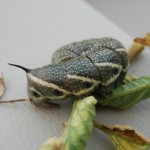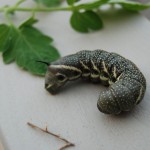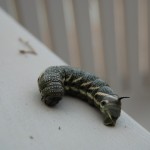It is certainly eye-catching, but I can’t help thinking that I really don’t want to fall in love with it. I do appreciate God’s creations, but there are some that I just would like to do without. This worm or actually caterpillar, was found on one of my tomato plants today, so I took a picture of it and attempted to match its mug shot on the Internet and maybe learn something about this UCI.
- UCI (Unidentified Chomping Insect)
- UCI (Unidentified Chomping Insect)
- UCI (Unidentified Chomping Insect)
- UCI (Unidentified Chomping Insect)
- UCI (Unidentified Chomping Insect)
- UCI (Unidentified Chomping Insect)
My inclination is to destroy it! Some articles that I’ve read encourage saving and even allowing these critters to continue to harvest and even provide other host plants for them. I think not!
If anyone can identify it I will appreciate it.







The dreaded Tomato Hornworm. It is a caterpillar, and can cause a great deal of damage on tomato plants. Absolutely kill them. They are voracious and can strip tomato plants very quickly. Hopefully you wont find too many of them. They deposit their eggs on the underside of the leaves and go unnoticed because their color matches the leaves so well. But the damage they do is easy to see.
Thanks!
I continued to look for them and found no more at this time, I will keep my eyes peeled.
As I searched the Internet I did not find anything that looked like it i.e. same colors, patterns etc. One of the references even stated that you begin to identify it by the plant that it was on and then says that they all have some variety of plant to host them? Confusing to say the least.
Well I knew that it meant no good for my crop so its a goner!
I did find a few -much smaller and totally green in color units that move in the “inch worm” manner, they too are goners.
Those little pale green worms that loop as they move inch-worm fashion are Cabbage Loopers. They got their name because they arch, or loop, their backs as they move along. These green caterpillars have faint whitish stripes along their sides. The adults are grayish night flying moths with a silver chevron on each wing. They are a serious pest to the cabbage family. Leaves develop ragged-shaped holes, and cabbage & broccoli heads become a hideaway. To control them you hand pick & destroy. Natural predators include lacewings, ladybugs, and trichogramma wasps. Yellow sticky traps are effective for loopers. For immediate control apply Bacillius thurngiensis var. berliner, or Neem oil soap. This information came courtesy of The Vegetable Gardener’s Bible.
According to the Vegetable Gardener’s Bible the description of the Tomato Hornworm follows:
As much as 4″ long and as thick as your pinky finger, hornworms are pale to medium green with chalky white streaks across the body. Small eyelike spots decorate their sides; their backsides sport a red or black spiky tail. They can devour most of a tomato plant in a day or two. Adults are large (4-5″) brownish gray moths with orange spots on the abdomen. Eggs are tiny greenish yellow balls on the undersides of the tomato leaves. To control: Spray small ones with Btb (Bacillius thuringiensis var. berliner) or Neem oil soap. When they are larger, handpick and drop into a can of soapy water. If you find a hornworm wearing clusters of small white eggs on its back, it’s best to leave it be. The eggs belong to a small braconid wasp that parasitizes and destroys the worm.
Cool, huh. I’m finding the eggs on the undersides of my bell pepper leaves. Uh oh.